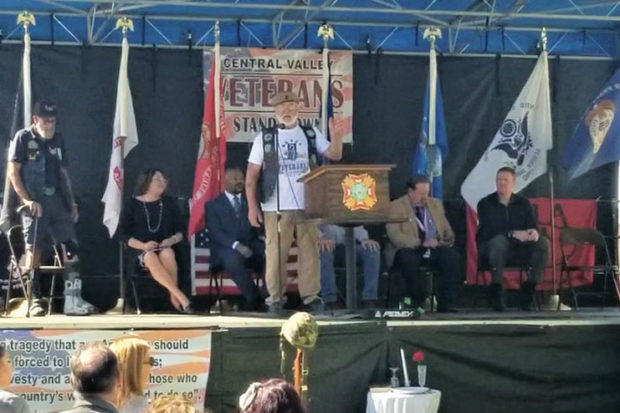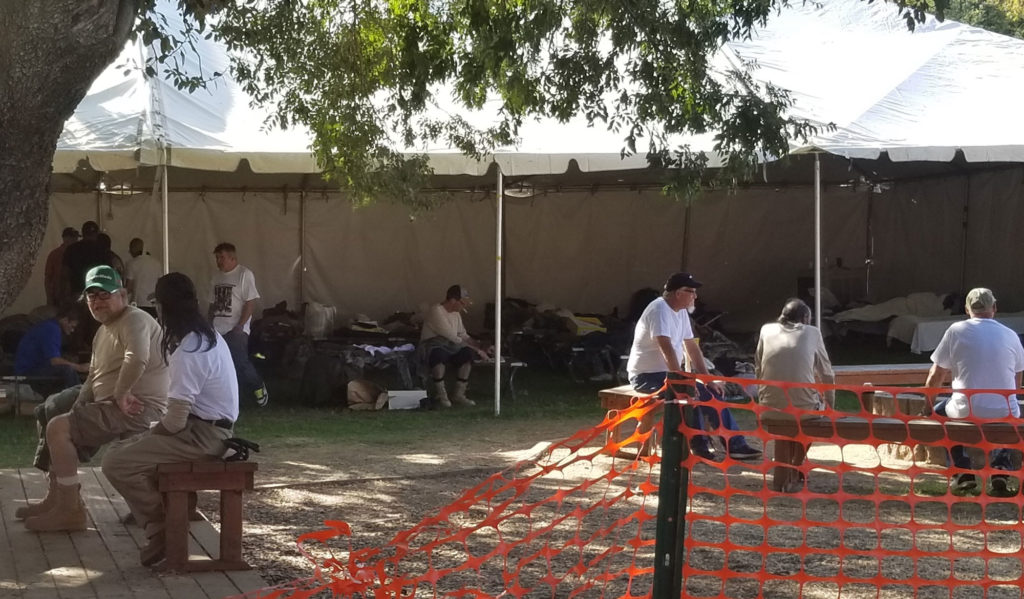
By Stan Santos
During the week of Sept. 16–20, the Central Valley Veterans (CVV) held their Veterans Stand Down 2019 at the Veterans of Foreign Wars Post 8900 in Fresno. In their 30th year, Veterans Stand Down has helped almost 30,000 veterans, active-duty military and their families. They provide community resources, social services and support.
Some veterans came to receive assistance during daytime hours, and others were bunked under a large canvas canopy at the rear of the Post 8900 facility. The Veterans Stand Down volunteers served more than a thousand meals for the overnight participants and visitors, which numbered more than 200.
On Sept. 18, the main reception hall of Post 8900 was packed with people and tables offering DMV and EDD services, education counseling, employment referrals, home financing, insurance and small business consultations. In one meeting room, there was a unique cooperative effort between the Fresno County courts and the CVV through the “Stand Down Court,” which assisted veterans with outstanding legal issues. As they exited the hall, veterans lined up for haircuts and shaves in two barber chairs manned by volunteers from the Tip Top Barbershop.
Another section housed a dental clinic with five chairs and workstations, run by Healing California, a nonprofit based in Pasadena. Dental services were provided by volunteer dentists, hygienists and assistants under Volunteer Coordinator Oriana John, a tall African American woman with a Caribbean accent. They maintain a busy calendar, providing services at Veterans Stand Downs throughout the Valley and the state.
On the lawn, there was a large canvas quonset (hangar) with a sign identifying “Mash 8900,” where vets went for hepatitis and HIV screenings, flu shots, blood pressure checks and administration of prescription and non-prescription medications.
Why the Veterans Stand Down?
In September 2019, the Department of Veterans Affairs (VA) reported that veteran suicides increased from 2016 to 2017, when 6,139 veterans took their own lives. Individuals who served in peacetime made up 21% of the national veteran population but one-third of all deaths by suicide in 2015 (Military Times).
Military.com reports that in 2018 a total of 321 active-duty members died by suicide. However, VA researchers estimate 450–550 active-duty, guard and reservists commit suicide each year, hence the widely quoted overall statistic of 20 suicides per day.
The Centers for Disease Control and Prevention reports that suicide rates in the United States have increased since 1999. And while mental health conditions often are seen as the cause of suicide, it is “rarely caused by any single factor.”
According to a 2015 fact sheet, “About Veterans’ Homelessness in the Central Valley,” veterans make up 8% of the U.S. population but 16% of homeless adults (Department of Housing and Urban Development). There are more homeless Vietnam-era veterans than those who died during the war.
The primary causes of homelessness among veterans are as follows:
- Lack of income due to limited education and transferable military to civilian skills (especially younger Iraq/Afghanistan vets)
- Combat-related physical and mental health issues and disabilities
- Substance abuse
- Weak social networks and inadequate support for adjustment to civilian life
Their needs are complex and range from legal assistance to family counseling and reconciliation, finances and eviction or foreclosure avoidance. These apply roughly the same to male and female veterans.
Other facts pertaining to veterans in Fresno:
- Approximately 50,000 veterans reside in Fresno County; 8%–10% are women.
- Madera ranks third highest in the nation in unhoused vets, with Fresno at 25th, although a tour of the city seems to indicate the number is extremely high.
- The VA Homeless Program identified 477 homeless veterans in Fresno County.

and assistance from different institutions during the Veterans Stand Down 2019.
Photo by Stan Santos
Vietnam Vets and Agent Orange
Like the World War II veterans of yesterday, Vietnam veterans are a vanishing generation of warriors who continue to die because of their service. From 1962 to 1971, the U.S. military sprayed nearly 20 million gallons of various chemicals in the theater of operations as part of the aerial defoliation program. Veterans recalled the musty smell of the chemicals in the air as they consumed contaminated food and water.
Agent Orange caused widespread famine and deaths among the civilian populations of Vietnam, Laos and Cambodia. The VA estimates that roughly 300,000 U.S. soldiers subsequently died from the effects—more than five times the 58,000 combat deaths. Agent Orange continues to cause life-threatening associated illnesses, including heart disease, various cancers, Hodgkin’s, diabetes and leukemia. There are also birth defects discovered in the children of Vietnam veterans, with higher numbers among women who served.
Depleted Uranium: The “Agent Orange” of the Iraq War Generation
Depleted uranium (DU) armor-penetrating munitions were widely used in the first Persian Gulf war and subsequent operations in Iraq, Afghanistan and Syria. An estimated 286 tons of DU munitions were fired by the United States in Iraq and Kuwait in 1991. During the Iraq invasion in 2003, thousands of DU rounds were again fired by U.S. jets and tanks; experts estimate the amount at 1,000–2,000 tons.
Approximately 650,000 veterans served in the first Gulf War. Of them, about 200,000 suffer from Gulf War Illness (GWI), which manifests itself in chronic pain, fatigue, memory impairment and other symptoms. Gulf War veterans are more likely to suffer from high blood pressure, high cholesterol, heart attack, arthritis and chronic bronchitis.
One research professor says that “Gulf War veterans are showing accelerated aging.” Despite this, the Government Accountability Office reports that the VA denies more than 80% of veterans’ claims for benefits for Gulf War–associated illnesses.
The Stand Down
The Community Alliance spoke with one veteran, Chris, who was observed helping to unload water on the first day. He was dressed for the street, in dirty shorts and a stained t-shirt. He described his three years on the street, moving from one sleeping spot to another, using his military training to survive, always “under the radar.” The next day he was dressed in clean clothes, eating healthy servings of meat and vegetables. He wondered aloud in between tears if the deaths caused by the actions of his squad members could be haunting them.
Another veteran and Stand Down volunteer, Dave, stood tall and proud in his camo pants, olive green t-shirt and cap, flashlight hooked on his belt. He was critical of the VA but felt privatization was not the answer. When he requested a referral to private treatment for his service-related conditions, he was given an appointment six months out. He also felt that private physicians are not equipped for treatment of specific service-related conditions. He is the only man left of a squad of 28 soldiers he served with.
Central Valley Veterans is a 501(c)(3) nonprofit comprising mostly vets and volunteers. The leadership includes President Deb Riordan, Vice President Bill Gonzalez (U.S. Army retired) and past Vice President John Schuler (U.S. Army retired). Deb and Alex Riordan handle finances, Schuler was in charge of the outdoor facilities and Gonzalez ran the kitchen and food preparation.
Following the Fresno Stand Down, Gonzalez said that they would be moving on to veteran gatherings in Atwater, Porterville, Oakhurst and other locations. For more info, visit centralvalleyveterans.org.
*****
Stan Santos is an activist in the immigrant and labor community. Contact him at alianzadefresno@gmail.com
